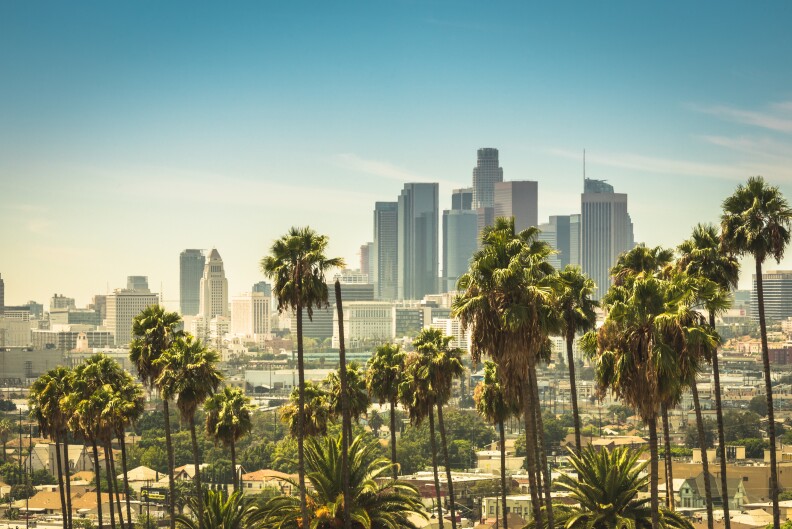How Palm Trees Became A Symbol of LA (And How to Tell Them Apart)

You can hardly go anywhere in Los Angeles without seeing a palm tree.
They line our streets from the boulevards of Beverly Hills to the foothills of the San Gabriels. These ubiquitous palms have become an intrinsic part of L.A.’s identity. In movies and music videos, on souvenir t-shirts for tourists and even on In-N-Out’s signature cups, palm trees represent the easygoing Southern California lifestyle.
Together with that famous sign in the hills, palms are shorthand for the Hollywood dream.
But like so many famous Angelenos, almost all of them came from elsewhere.

-
We're here to help get your outdoor space looking great with practical tips, news and what you need to do to keep conservation in mind.
Spanish missionaries first introduced the biblically-significant palm plants to the area in the 18th century. Prized for their “exotic” aesthetic, they later became a popular decorative plant among wealthy Angelenos around the turn of the century.
The palm craze really took root in the 1930s when around 25,000 of the trees were planted by workers as part of an unemployment relief program ahead of the Olympic games.
“So they're actually like a pretty fascinating case study for this intersection in between our human world and the ecological world that co-exists here in Los Angeles,” explains Evan Meyer, who is executive director of the Theodore Payne Foundation, which is dedicated to California native plants.
These palms have really astounding capacity to survive in places that I wouldn't imagine they could survive.
Today, there is some disagreement over whether these non-native palms, which...
- suck up water
- provide little to no shade
- are known for catching fire
... play a positive role in L.A.’s environment.
Nature expert Marcos Trinidad digs into that debate on the latest episode of the Human/Nature podcast from LAist Studios with Meyer and other experts.
“These palms have really astounding capacity to survive in places that I wouldn't imagine they could survive. So we see them sprouting on the sidewalks, right?,” Lorena Villanueva-Almanza, who has a Ph.D. in Botany and Plant Sciences from the UC Riverside, explains in the episode.
“They're so capable. And actually the Mexican skyduster is considered an invasive species in California, while in its natural habitat, it's almost endangered…The irony of it, it's almost tragic.”
In any case, L.A.’s iconic palm trees are not going anywhere fast, so you might as well learn how to tell them apart. Here are three of the most common species you’re likely to spot around the city:
Mexican Fan Palms
(Washingtonia robusta)

Also known as “skydusters,” these tall boys are perhaps the most prolific — and visually striking — of L.A.’s palm species. Growing between 70 to 100 feet, they produce up to 50 of their namesake fan-shaped leaves per year, which hang in a skirtlike formation below the crown if they are not trimmed. Though they are considered invasive in some parts of Southern California, they are actually almost extinct in their native range of the Baja California peninsula.
California Fan Palms
(Washingtonia filifera)

Visually similar to Washingtonia robusta, these palms are slightly shorter and wider than their Mexican cousins, and hybridize with them freely. While they aren’t native to L.A., they are the only palm in the area that originated in Southern California, historically occurring near water in the Sonoran and Mojave Deserts. These “palm oases” were once used as village sites by indigenous peoples of the Kamia and Cahuilla tribes, providing fruits, fibers for clothing and baskets, and house-making materials.
Canary Island date palms
(Phoenix canariensis)

Planted in wealthy neighborhoods like Beverly Hills and Hancock Park during the 1920s and 1930s, this Canary Island native can be identified by its featherlike fronds, bright orange flowers, and pineapple-like trunk (they are nicknamed “pineapple palms.”) One of the priciest decorative palms, it is also the most susceptible to pests like the South American palm weevil, which eat away at its trunk and eventually cause its crown to fall.
-
The state's parks department is working with stakeholders, including the military, to rebuild the San Onofre road, but no timeline has been given.
-
Built in 1951, the glass-walled chapel is one of L.A.’s few national historic landmarks. This isn’t the first time it has been damaged by landslides.
-
The climate crisis is destabilizing cliffs and making landslides more likely, an expert says.
-
Lifei Huang, 22, went missing near Mt. Baldy on Feb. 4 as the first of two atmospheric rivers was bearing down on the region.
-
Since 2021, volunteers have been planting Joshua tree seedlings in the Mojave Desert burn scar. The next session is slated for later this Spring, according to the National Park Service. Just like previous times, a few camels will be tagging along.
-
There are three main meteorological reasons why L.A. is so smoggy — all of which are affected when a rainstorm passes through and brings clearer skies.











